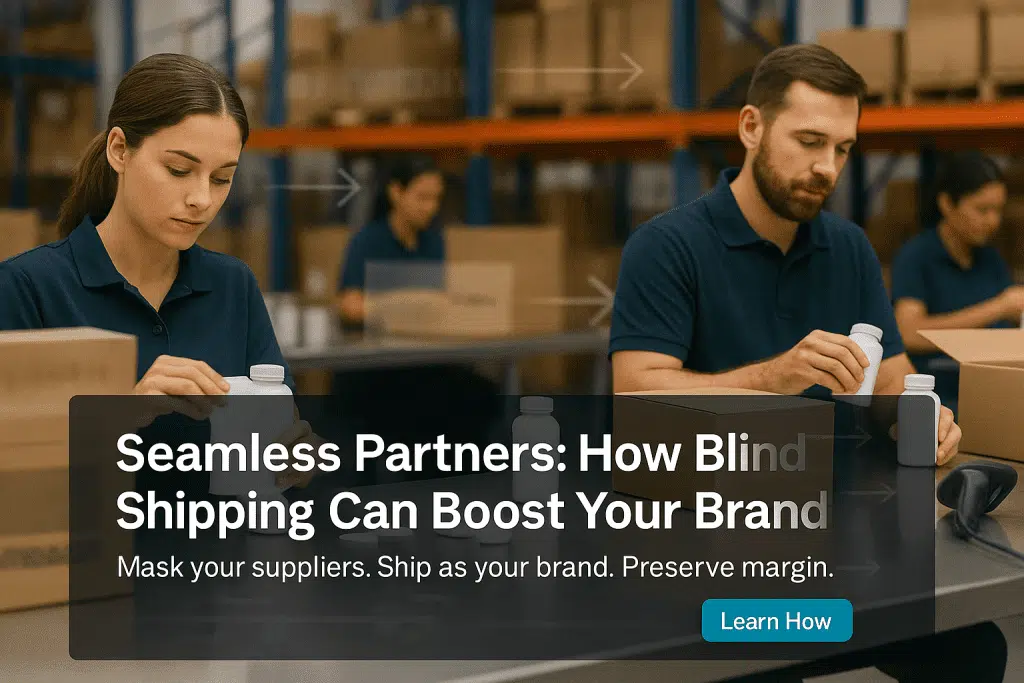Author: Jason Martin
Reviewed by: Supply Chain Solutions Lead
Last updated: September 24, 2025
Executive TLDR
Blind shipping hides supplier or 3PL details on labels and documents so buyers see only your brand.
A seamless partner setup routes orders, prints the right labels, and updates tracking without manual edits.
Standardize carton markings, packing slips, and return addresses to prevent reveal and chargebacks.
Use clear ASN data, FEFO controls, and right sized packaging so orders ship fast and margin stays healthy.
Start with a pilot, confirm accuracy, then scale blind shipping across channels.
Want blind shipping that just works — Contact Product Fulfillment Solutions
Table of contents
What blind shipping is
Why blind shipping matters
The setup checklist
Quality controls that keep you safe
Cost levers you can pull
Why Product Fulfillment Solutions
FAQ
What blind shipping is
Blind shipping keeps your supplier or 3PL invisible to the buyer. Labels, packing slips, and return details show only your brand. The goal is simple, protect your relationships and pricing while orders move quickly.
Why blind shipping matters
Brand control: Buyers interact with your name, not your backend.
Margin protection: Prevent price shopping against your supplier or 3PL location.
Channel compliance: Some marketplaces and retailers require unbranded labels and specific packing slips.
Operational speed: When blind shipping is baked into the flow, your team spends less time editing labels or documents.
If you want the foundation in place, start with 3PL fulfillment and ecommerce fulfillment services.
The setup checklist
1) Decide the sender of record
Set the ship-from and return address to your brand or an approved address. Keep it consistent across channels.
2) Standardize paperwork
Create a clean packing slip template, your logo, order details, and support info. Remove supplier names and internal codes. For retail or wholesale, align with EDI solutions and connections.
3) Lock label logic in systems
Map each channel to the correct label and return address. Automate this in your WMS or via partner integrations so staff are not editing by hand.
4) Control inserts and marketing
Use neutral inserts, how-to, care, reminders. If you add promos, ensure they match the buyer’s channel rules.
5) Train the loop
Post a short blind shipping SOP at pack stations. Include a final check, return address, packing slip version, inserts allowed.
6) Pilot with real orders
Run a one week pilot on a subset of SKUs. Validate labels, packing slips, and tracking events. Confirm that support details route back to your team.
If kitting is part of your model, wire in kitting assembly services so bundles follow the same blind standards.
Quality controls that keep you safe
ASN discipline: Match carton contents to the ASN so receiving is fast and accurate. Clear data shortens dock to stock to 1 to 3 days.
FEFO for consumables: Capture lot and expiry at receiving, enforce FEFO at pick to keep freshness and reduce waste.
Scan at pick and pack: Add a second scan for look-alike SKUs to stop swaps.
Document checks: Spot-check packing slips and labels daily to confirm the correct return address and no supplier references.
Returns routing: Returns should come back to your chosen address and process, not to a supplier by mistake.
For added space and staging, see warehousing and storage solutions.
Cost levers you can pull
Right sized packaging: Use a simple box or mailer matrix to lower DIM charges on small parcels. Pair with discounted shipping rates to protect margin.
Centralized shipping: A central U.S. node, Cincinnati based, reaches most customers in 1 to 3 days by ground.
Exception lanes: Create a small relabel zone near pack so the main line never stalls.
Batch label printing: Print only after the last scan at pack to avoid waste and mislabels.
Need visibility across everything, plug in real-time information.
Why Product Fulfillment Solutions
Seamless blind shipping flow with branded packing slips, return addresses, and consistent label logic.
Barcode first receiving aligned to your ASN, predictable dock to stock speed.
FEFO and lot or expiry controls for supplements, vitamins, and health and wellness goods.
Pick and pack standards and light assembly for bundles and subscription boxes.
Small parcel optimization to keep shipping costs in check while staying on brand.
Retail and EDI ready for wholesale overlays and compliance at scale.
Explore b2b and retail fulfillment when you add store or distributor orders.
FAQ
What is the difference between blind and double blind shipping
Blind hides the supplier or 3PL, double blind hides both shipper and buyer details from each other in the paperwork. Most brands only need blind.
Will blind shipping slow orders
Not if it is set in the systems. Labels and packing slips should print with the correct branding by default.
Can we still include inserts
Yes, as long as they fit the channel rules. Keep messaging neutral and helpful. Use QR codes for how-to, not external promotions that break policies.
How do returns work with blind shipping
Set a single brand return address and process. Post-check that carriers and systems use that same address on every label.
What if a supplier insists on their address
Use a brand-approved return address in the label logic and route returns to your process. Avoid manual edits at the bench.

